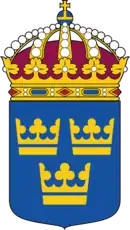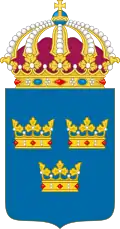Swedish Freedom of the Press Act
The Freedom of the Press Act (Swedish: Tryckfrihetsförordningen) is one of four Fundamental Laws of the Realm (Swedish: rikets grundlagar) and thus forms part of the Swedish Constitution.[1] The Act regulates matters regarding freedom of press and principle of public access to official records. The Freedom of the Press Act as well as the Fundamental Law on Freedom of Expression (Swedish: Yttrandefrihetsgrundlagen) is one of the two "basic media acts" in Sweden. The Freedom of the Press Act is derived from the Freedom of the Press Act of 1766; the legislation is regarded as the world's first law supporting the freedom of the press and freedom of information.[2] In its first version, it brought freedom of the press in Sweden - then under the Holstein-Gottorp monarchy - to a level then only rivaled by the liberal Dutch republic and the United Kingdom of the Bill of Rights of 1689.
| Tryckfrihetsförordningen | |
|---|---|
 | |
| Citation | Tryckfrihetsförordning (1949:105) |
| Territorial extent | Sweden |
| Enacted | 1766 (first version); 1949 (current) |
| Commenced | 1 January 1950 |
| Keywords | |
| Constitution of Sweden Monarchy of Sweden | |
 |
|---|
| This article is part of a series on the politics and government of Sweden |
History
Freedom of the Press Act of 1766 and the Age of Liberty
Following the death of King Charles XII in 1718, the Swedish throne was passed to a series of weak kings. During Adolf Frederick's weakened rule in the age of liberty of the Swedish 18th century with its absence of a single governor, greater decision-making space for the parliament, and decline of the monarchy led to an increase in the importance of the Riksdag. Though the Riksdag retained its four chambers—for nobility, clergy, townsmen, and farmers—it developed two strong parties known as the “Hats” and the “Caps.”[2]
In 1765 the Swedish government initiated a comprehensive revision of the constitution. The Ostrobothnian priest Anders Chydenius was a driving force and author behind one of the three pleas for freedom of the press submitted to parliament.[3] In his writing, he concludes:
No evidence should be needed that a certain freedom of writing and printing is one of the strongest bulwarks of a free organization of the state, as, without it, the estates would not have sufficient information for the drafting of good laws, and those dispensing justice would not be monitored, nor would the subjects know the requirements of the law, the limits of the rights of government, and their responsibilities. Education and ethical conduct would be crushed; coarseness in thought, speech, and manners would prevail, and dimness would darken the entire sky of our freedom in a few years.
Under the leadership of the Anders Chydenius, the Caps at the Swedish Riksdag in Gävle on December 2, 1766, passed the adoption of a freedom of the press regulation that stopped censorship and introduced the principle of public access to official records in the Swedish authority. Excluded were defamation of the king's majesty and the Swedish Church.
King Gustav III revisions
At the time of King Gustav III accession, the Swedish Riksdag held more power than the monarchy; however, the Swedish Riksdag was divided between the two rival parties:[4] the Hats and Caps. The subsequent attempts of the dominant Caps to reduce him to a roi fainéant (a powerless king) encouraged him to consider a coup d'état. In 1772, King Gustav III seized power through a coup d’état. Two years later, the Act was largely rolled back when he presented an alternative Freedom of the Press Act, leaving it effectively to the king's discretion to decide what could be legally printed by inversing the basic premise; rather than promoting the liberty of anything not explicitly deemed illegal, the Act only protected that which was not prescribed verbatim as legal, in effect undercutting its protections.[3] Penalties were made more severe and violations could, in many cases, lead to execution. The new act also introduced strong limitations on the principle of access to public information. The Act was continually revised to strengthen the grip of the government, the last made in 1790, in the wake of the very recent French Revolution. Freedom of speech, not explicitly protected by the act (and not by the Constitution until 1992) was also severely curtailed.[5]
Restoration and the House of Bernadotte
The Act was replaced by a 1792 version, following Gustav's death, which arguably eased some restrictions and entered the principles of publicity of information, a crucial concept in Swedish constitutional law. It was finally replaced by the 1809 Freedom of the Press Act (alongside the lines of the liberal 1809 Constitution which was itself replaced by a more reactionary 1812 version under the then-Crown Prince Jean-Baptiste Bernadotte, who ascended to the throne as Charles XIV John in 1818. It most notably allowed the right of the state, under certain circumstances, to rescind (indragningsmakten) the rights of any individual paper. This power was frequently exercised under Charles' rule, and circumvented, most notably by the newspaper Aftonbladet, which between 1835 and 1844 was banned numerous times. The newspaper's editor, Lars Johan Hierta, avoided the ban by founding a new newspaper after every conviction, eventually succeeding by avoiding prosecution for the "Twenty-Seventh Aftonbladet", technically a separate publication than the manifold preceding it (initially using monikers such as "The New Aftonbladet" and "The Newer Aftonbladet". After Charles' death in 1844, this practice ceased, and free press prevailed. The power to rescind, with increasing legal limitations and technicalities, long survived Charles XIV John and was ended only with the current 1949 version of the Act. A major revision was made in 1937, containing most of the provisions associated with the current law and, most notably, enshrining the principle of publicity of information.
Freedom of the Press Act of 1949
In 1949 the law was revised, but its main principles are still the same as in 1766.[2]
References
- Riksdagsförvaltningen. "The Constitution". www.riksdagen.se. Retrieved 2019-11-28.
- "Freedom of the Press Act of 1766 | Swedish legislation". Encyclopedia Britannica. Retrieved 2019-11-28.
- "20 milestones of Swedish press freedom | Official site of Sweden". sweden.se. 2016-12-01. Retrieved 2019-11-28.
- "Gustav III | king of Sweden". Encyclopedia Britannica. Retrieved 2019-11-28.
- The Free Speech Act was passed in 1991 and came into force on January 1, 1992. In spite of its name, it only affects some forms of free speech, being a digital age complement (rather than replacement) to the Freedom of the Press Act, the first of its kind. Free speech for individual citizens and individuals is governed by the Instrument of Government of 1974, although litigation would see no limitations on its restriction through judicial review until the 2000s. The most effective free speech guarantee in Swedish law hitherto would be the European Convention on Human Rights, ratified in 1952 and in force since 1953.